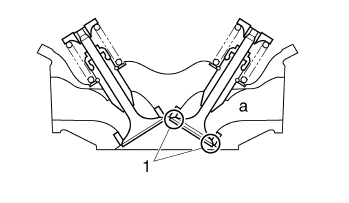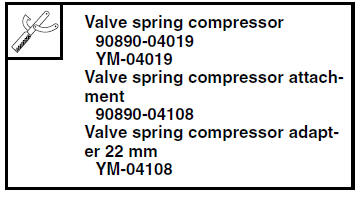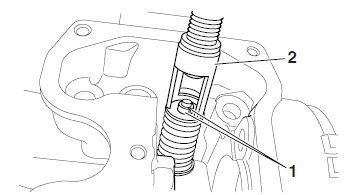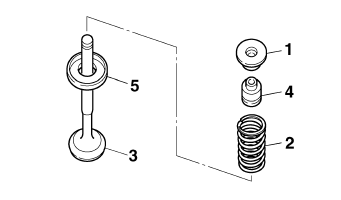Yamaha YZF-R125 Service Manual: Removing the valves
The following procedure applies to all of the valves and related components.
NOTE:
Before removing the internal parts of the cylinder head (e.g., valves, valve springs, valve seats), make sure the valves properly seal.
1. Check:
- Valve sealing
Leakage at the valve seat
 Check
Check
the valve face, valve seat, and valve seat width.Refer to "CHECKING THE VALVE SEATS" on page 5-20.
a. Pour a clean solvent "a" into the intake and exhaust ports.
b. Check that the valves properly seal.
NOTE:
There should be no leakage at the valve seat "1".

2. Remove:
- Valve cotters "1"
NOTE:
Remove the valve cotters by compressing the
valve spring with the valve spring compressor
and the valve spring compressor attachment "2".

3. Remove:
- Upper spring seat "1"
- Valve spring "2"
- Valve "3"
- Valve stem seal "4"
- Lower spring seat "5"
NOTE:
Identify the position of each part very carefully so that it can be reinstalled in its original place.

 Checking the valves and valve guides
Checking the valves and valve guides
The following procedure applies to all of the
valves and valve guides.
1. Measure:
Valve-stem-to-valve-guide clearance
Out of specification Replace the
valve
guide.
Valve-stem-to-valve ...
Other materials:
Checking the shift drum assembly
1. Check:
Shift drum groove
Damage/scratches/wear Replace
the shift
drum assembly.
Shift drum segment "1"
Damage/wear Replace the
shift drum assembly.
Shift drum bearing "2"
Damage/pitting Replace the
shift drum assembly.
...
Starting the engine
In order for the ignition circuit cut-off
system to enable starting, one of the
following conditions must be met:
The transmission is in the neutral
position.
The transmission is in gear with
the clutch lever pulled and the sidestand
up.
1. Turn the key to "ON" and make
sure ...
Troubleshooting
Any of the following fail to light: headlight, high beam indicator light,
taillight, license plate light, auxiliary
light or meter light.
NOTE:
Before troubleshooting, remove the following part(s):
1. Seats
2. Fuel tank
...

